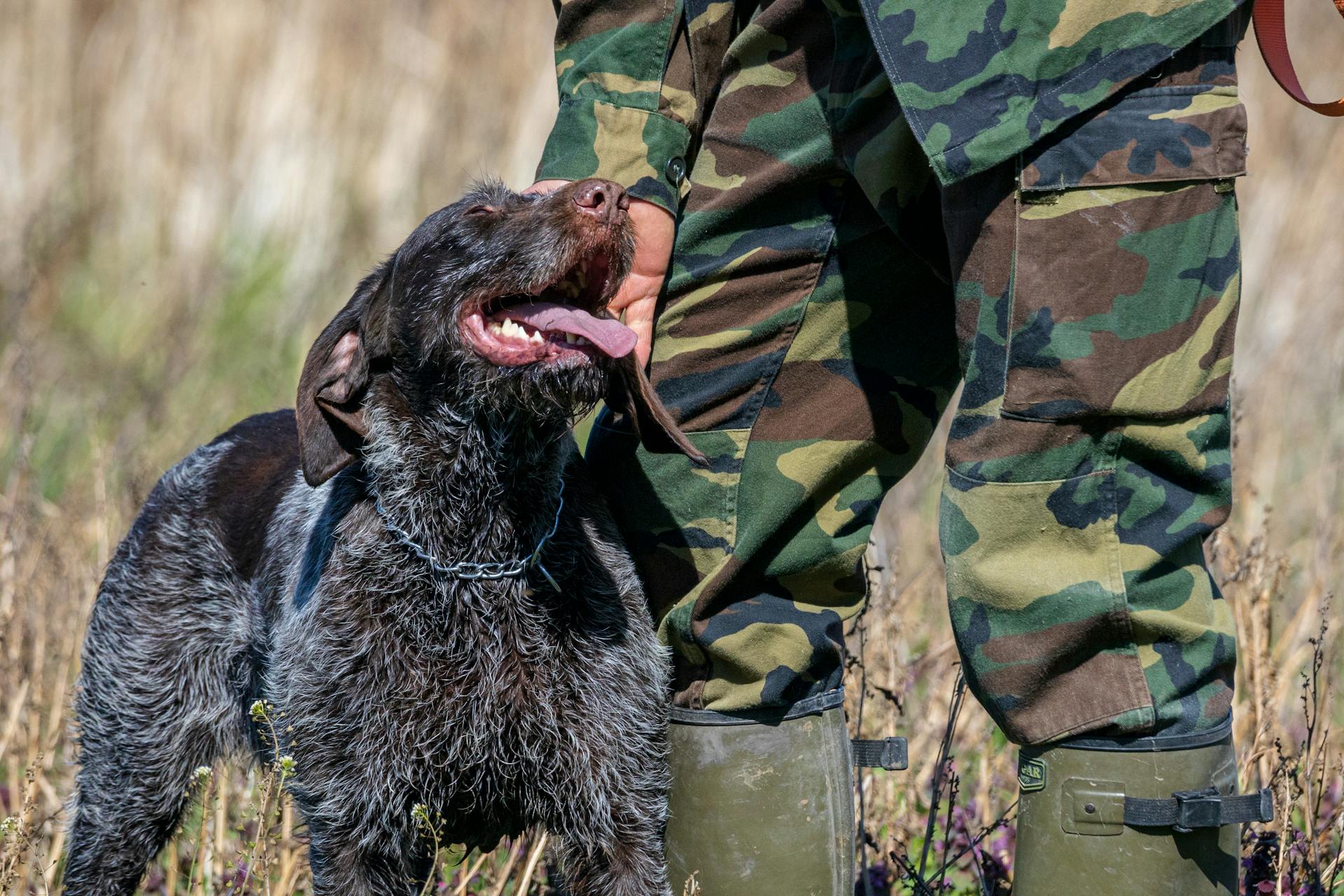
Military dogs have been serving alongside their human counterparts for decades, playing a vital role in various military operations. They're trained to detect explosives, track down enemy combatants, and provide crucial support in combat zones.
Their keen sense of smell allows them to detect explosives and narcotics with ease, making them invaluable assets in explosive detection missions. In fact, one military dog was able to detect over 100 pounds of explosives in a single mission.
Military dogs are also trained to track down enemy combatants, using their keen sense of smell and agility to navigate through dense terrain. Their speed and agility make them perfect for tracking down targets in challenging environments.
These highly trained animals have been serving with honor and devotion, putting their lives on the line to protect their human counterparts.
For another approach, see: Dog Smell
Dogs in Action
Marine Lance Corporal Alfredo Salazar formed a strong bond with Kaiser, a German Shepherd Dog, during the Vietnam War. Kaiser was quickly hit during an ambush, and Salazar said it was like losing one of the closest friends he ever had.
K9s have been used in the military since at least the Civil War, but it wasn't until WWII that the first K9 corps was created. Military Working Dogs, also known as MWDs, have worked alongside soldiers in various roles, including sentries and scouts.
Today, over 1,600 K9s are working globally in the military, and all are trained at the 341st Training Squadron at Lackland Air Force Base in San Antonio, Texas.
K9s in the Military
K9s in the Military are a vital part of the armed forces, serving in various roles such as sentry, scout, and explosive detection. They have been used by the military since at least the Civil War.
The first Air Force sentry dog school was activated at Showa Air Station, Japan, in 1952. Today, all United States military working dogs and their handlers are trained at the 341st Training Squadron at Lackland Air Force Base in San Antonio, Texas.
There are currently over 1,600 K9s working globally in the military. The Department of Defense breeds about 13% of the dogs in the military working dogs program – the rest are purchased from elite breeders domestically and internationally.
Each K9 military candidate spends six months with a foster family and then is returned to the 341st Training Squadron, where they receive specialized intensive training. This training includes bite work, obedience, odor sensitivity, and environmental training to simulate combat zones.
Only 50% of dogs who enter the Military Working Dog Training Program graduate to become military working dogs. After the 120-day training program, the K9s must graduate from the Military Working Dog Training Program.
Here's a breakdown of the roles military working dogs can play:
Military working dogs have played a crucial role in various wars, including World War I, World War II, and the Vietnam War. They have been recognized for their bravery and loyalty, with many receiving medals and accolades for their service.
Some notable military working dogs include Sergeant Stubby, who served in World War I and became the most famous canine hero of the war; Smoky, a four-pound Yorkshire Terrier who served in World War II and became the first therapy dog; and Cooper, a Labrador Retriever bomb sniffing dog who served in Iraq and was killed in action alongside his handler, Corporal Kory Wiens.
Dogs Left Behind
About 4,000 dogs served in the Vietnam War.
The US government classified these dogs as military equipment, which led to many being left behind after the war.
Only 200 dogs were brought back to the United States, leaving the rest behind.
The National Defense Authorization Act for FY2013 was signed into law, allowing the military to transfer retired dogs to locations for adoption and provide them with veterinary care.
Dogs are now often given military ranks, and sometimes they even outrank their handlers.
Military Dogs in Service
Military dogs have been working alongside soldiers in the United States since at least the civil war. The first Air Force sentry dog school was activated at Showa Air Station, Japan, in 1952.
In 1966, four sentry dog teams from Andrews Air Force Base were trained as patrol dogs. By 1969, the Air Force made patrol dogs the standard military working dog.
Today, all United States military working dogs and their handlers are trained at the 341st Training Squadron at Lackland Air Force Base in San Antonio, Texas. There are currently over 1,600 K9s working globally in the military.
Military dogs are trained to perform various tasks, including bite work, obedience, odor sensitivity, and environmental training to simulate combat zones. This training takes 120 days to complete.
Only 50% of dogs who enter the Military Working Dog Training Program graduate to become military working dogs.
You might enjoy: All about Dogs Dog Training
Sources
- https://www.army.mil/article/56965/military_working_dogs_guardians_of_the_night
- https://dogtails.dogwatch.com/2023/11/11/canine-military-heroes-5-important-service-dogs-who-should-be-celebrated/
- https://dogtime.com/holiday/64857-memorial-day-remembering-military-dogs-killed-in-action
- https://www.nationalgeographic.com/magazine/article/dogs-war-soldiers-military-afghanistan
- https://www.ppak9.org/blog/the-history-of-k9s-in-the-military-military-working-dogs/
Featured Images: pexels.com

